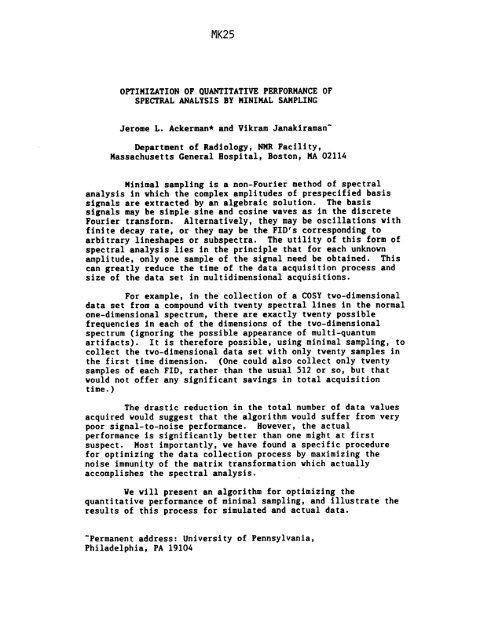th - 1987 - 51st ENC Conference
th - 1987 - 51st ENC Conference
th - 1987 - 51st ENC Conference
You also want an ePaper? Increase the reach of your titles
YUMPU automatically turns print PDFs into web optimized ePapers that Google loves.
MK25<br />
OPTIMIZATION OF QUANTITATIVE PERFORMANCE OF<br />
SPECTRAL ANALYSIS BY MINIMAL SAMPLING<br />
Jerome L. Ackerman* and Vikram Janakiraman-<br />
Department of Radiology, NNR Facility,<br />
Massachusetts General Hospital, Boston, MA 02114<br />
Minimal sampling is a non-Fourier me<strong>th</strong>od of spectral<br />
analysis in vhich <strong>th</strong>e complex amplitudes of prespecified basis<br />
signals are extracted by an algebraic solution. The basis<br />
signals may be simple sine and cosine raves as in <strong>th</strong>e discrete<br />
Fourier transform. Alternatively, <strong>th</strong>ey may be oscillations wi<strong>th</strong><br />
finite decay rate, or <strong>th</strong>ey may be <strong>th</strong>e FID's corresponding to<br />
arbitrary lineshapes or subspectra. The utility of <strong>th</strong>is form of<br />
spectral analysis lies in <strong>th</strong>e principle <strong>th</strong>at for each unknown<br />
amplitude, only one sample of <strong>th</strong>e signal need be obtained. This<br />
can greatly reduce <strong>th</strong>e time of <strong>th</strong>e data acquisition process and<br />
size of <strong>th</strong>e data set in multidimensional acquisitions.<br />
For example, in <strong>th</strong>e collection of a COSY tvo-dimensional<br />
data set from a compound vi<strong>th</strong> tventy spectral lines in <strong>th</strong>e normal<br />
one-dimensional spectrum, <strong>th</strong>ere are exactly tventy possible<br />
frequencies in each of <strong>th</strong>e dimensions of <strong>th</strong>e two-dimensional<br />
spectrum (ignoring <strong>th</strong>e possible appearance of multi-quantum<br />
artifacts). It is <strong>th</strong>erefore possible, using minimal sampling, to<br />
collect <strong>th</strong>e two-dlmensional data set vl<strong>th</strong> only twenty samples in<br />
<strong>th</strong>e first time dimension. (One could also collect only twenty<br />
samples of each FID, ra<strong>th</strong>er <strong>th</strong>an <strong>th</strong>e usual 512 or so, but <strong>th</strong>at<br />
would not offer any significant savings in total acquisition<br />
time.)<br />
The drastic reduction in <strong>th</strong>e total number of data values<br />
acquired would suggest <strong>th</strong>at <strong>th</strong>e algori<strong>th</strong>m would suffer from very<br />
poor signal-to-noise performance. Sovever, <strong>th</strong>e actual<br />
performance is significantly better <strong>th</strong>an one might at first<br />
suspect. Most importantly, we have found a specific procedure<br />
for optimizing <strong>th</strong>e data collection process by maximizing <strong>th</strong>e<br />
noise immunity of <strong>th</strong>e matrix transformation which actually<br />
accomplishes <strong>th</strong>e spectral analysis.<br />
We will present an algori<strong>th</strong>m for optimizing <strong>th</strong>e<br />
quantitative performance of minimal sampling, and illustrate <strong>th</strong>e<br />
results of <strong>th</strong>is process for simulated and actual data.<br />
"Permanent address: University of Pennsylvania,<br />
Philadelphia, PA 19104













